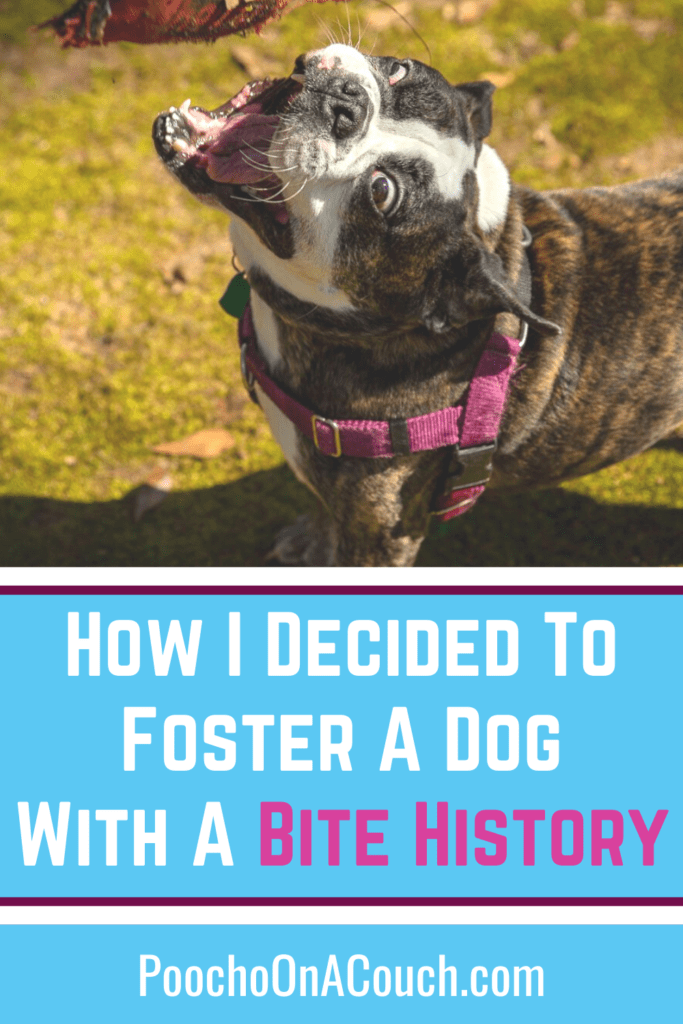I’m currently fostering a dog that bites. In fact, his family reports about 20 or so bites in this dog’s 5 years of life.
He’s bitten a child.
He’s left a scar.
He’s been here four weeks and he’s bitten me once. He’s also air-snapped at me. (Technically, that’s bite number 2.)
And I completely think this is an adoptable dog. Highly adoptable.
Full disclosure – I’ve also arranged for the behavioral euthanasia of a dog that bites. That dog was not adoptable at all. He was a dangerous dog, even in the capable hands of a foster home.
Sherlock’s Story
Sherlock is a 5-year-old English Bulldog and Boston terrier mix. He was given up by his family for medical reasons: he needs bilateral knee repair and the family is unable to provide him with that level of care.
I’ll add he needed to be surrendered because he was becoming increasingly overwhelmed in the home with two children under the age of three and one more on the way. He’d bitten one of the children already – no injury, but a child’s skin is so tender. It could have been worse!
Prior to the couple expanding their family, Sherlock had bitten them, too. Nothing major, but he’d left bruises and broken the skin a few times. Never had any of his bites required any medical attention or first aid beyond some triple antibiotic and a bandaid.
The one scar he left is tiny, and on the tip of a finger.
Sherlock had never bitten a house-guest, a stranger, and was always cooperative for his veterinary appointments.

Why A Dog Bites
I won’t go in-depth as to why dogs bite, plenty of pet professionals have done a great job of that already. If you want to research that topic you can, but here are a couple of over-simplified bullet points:
- All dogs have the potential to bite, even the most gentle and patient dogs will bite if they feel the need.
- Dogs bite because it is the choice they make at the moment. That bite is either in context with what is happening at the moment, or it is out of context with what is happening and the dog could have made a different (and better) choice.
How I Decide If I Will Foster A Dog That Bites
I Ask About Bite Severity Before Fostering A Dog That Bites
Get a thorough history whenever you can. Family, vet records, training, history. It will be invaluable to you. Here’s what I learned from my phone conversations with Sherlock’s family:
Sherlock left his scar on his owner’s fingertip. Not on her arm or her thigh or her face. Her fingertip.
It is really easy to scar your hand. Mine is scarred – once from an oven burn, once from a bicycle accident when I was a kid, once from the time Otis bit me, and a few others that I can’t remember what happened.
Per the family, Sherlock’s bites never left a deep wound, a wound that needed stitches, or one that caused deep tissue bruising or swelling.
His “nips” did leave surface bruising a few times as well as break the skin.
In short, Sherlock’s bites were low on the Dunbar Bite Scale.
I Ask About Bite Triggers – Why and When Does A Dog Bite?
I wanted to learn more about when Sherlock bites. What is happening when he bites? Is there a pattern? Does he bite a specific person? In a specific place? At a particular time of day? When sleeping? When active? When energetic? When tired?
It was harder for the family to tell me these details. Once, Sherlock snapped at the wife’s face, but I learned that Sherlock was on his favorite chair, napping. The wife decided she wanted to give Sherlock some affection so she moved in close to pet him. He snapped at her.
Could he have made a better decision? Yep. Given his history, could this reaction from him be anticipated? Yep.
The time the wife’s finger was injured and scarred, Sherlock was laying on the bed. The wife asked Sherlock to move over. More than once. He ignored her. So she attempted to physically move Sherlock to a different area of the bed. He bit her hard enough to cause her finger to bleed.
After that incident, the family made the smart decision to not allow Sherlock to sleep with them at night. Sherlock is no worse for wear. I would have made the exact same decision and do. Sherlock sleeps in a crate at night.
When I Can, I Meet The Dog
I decided to meet Sherlock in person in his home.
Sherlock met me at the door. I relaxed my stance, put my hands behind me, and said, “hey, buddy” as he sniffed my legs.
I won’t lie. I was nervous.
He didn’t linger or sniff me for a socially inappropriate length of time. Three seconds later, he moved away and I was able to walk into the house.
The husband said, “he can tell you are a dog person.”
Maybe. What I didn’t do was reach out to pet this dog or hover over him. I didn’t crowd his space.
My Observations
The room was small and cozy with three adults, two babies, and Sherlock. The room was busy. The children were following Sherlock around and Sherlock was playing fetch with his dad.
When Sherlock decided to take a break by lying down on the fireplace hearth (he is a bulldog and overheats quickly) the children swarmed him. Sherlock would get up and move. The children followed him.
For an hour-and-a-half, Sherlock was in constant motion. He was incredibly patient with the children. Really patient.
My Concerns
Truth be told, I fully expected to see Sherlock bite during my visit. He had plenty of reason to be frustrated. I was impressed with his restraint and his attempts to distance himself from the children. He really did have some good coping skills.
If I’d been in that home in a different capacity (i.e. if I was helping them problem solve) I would have intervened. I was not. I was there to assess Sherlock for entry into a rescue organization.
I asked the wife where the child was and what was happening when Sherlock bit her.
She recalled that Sherlock was at the front door which is located next to one corner of the room. The front door is boxed in on two sides by furniture.
My Impressions
It’s highly likely, although I obviously can’t be sure, that Sherlock may have felt trapped or cornered, unable to get away from the child. Maybe he’d lost his patience. In contrast, the fireplace hearth had two ways for Sherlock to escape the children’s attention, and he repeatedly chose that option again and again and again while I was there. He never lost his patience.
I also have a hunch that Sherlock has some mild resource guarding issues around bones/toys and food. This may influence whether or not Sherlock goes into a home with other pets.
I learned more about Sherlock
As we wrapped up my visit, I gathered a few extra bits of information: Sherlock can be possessive of certain toys, especially dog bones.
Sherlock also does not like to be touched on his stomach. And, Sherlock doesn’t like to be held by his hips. Good to know. I won’t do that.
And I also asked a very specific question: Had Sherlock ever charged or lunged before biting. The answer to that was “no.”

My Decision To Foster This Dog That Bites
After I met with the family and had the opportunity to meet Sherlock in his home environment, I could see his strengths outweighed his issues. He needed an opportunity to live in a different home environment.
Also influencing my decision was the fact that Sherlock’s bites were low in frequency, and the severity never increased. Sherlock reportedly only bit family members and the wife more than anyone else.
I still expected to get bitten! And I did. I’ll tell you about that in a minute.
Bringing Sherlock Home
I set up Sherlock’s space using a modified quarantine protocol I use for contagious dogs. Since Sherlock was the only dog in his previous home, and because Otis can be a jerk, I opted to keep Sherlock separated from my pets.
I spent a lot of time with him during the day because his space was also my office.
I also used the 3-3-3 rule for bringing home a new dog.
I rarely pet him those first three days. I didn’t ignore him, though! I used the Canine Consent Test every single time I interacted with him. When he showed no interest in me, I kept my hands to myself.
Today marks 4 weeks and two days since Sherlock came to stay here. Now, he asks to be petted – scratched, really, and I can scratch him on his neck, his jowls, his sides, back, and hips. I don’t touch his stomach. Why tempt fate when the family let me know he doesn’t like it.
That Time Sherlock Gave Me An Airsnap
Sherlock can entertain himself for hours with a ball or a chew bone. He also slobbers a lot!! So, his paws get really, really gooey with saliva. I think the saliva can be irritating to his skin because I looked over at him one morning and saw that he was grabbing his dewclaw nail with his teeth and pulling on it over and over.
I thought, that can’t be good.
I tried to get his attention verbally and he was enthralled in his activity. So, I leaned over and tap-tap-tap I touched his hip with two fingers while calling his name.
He didn’t like that! I saw his face a split second before he wheeled around to correct me. I moved my hand and he missed me. Missed me on purpose? I don’t know.
Even an air snap or near miss is technically a bite.
NOTE TO SELF.
The Time Sherlock Bit Me For Real
The first time I trimmed Sherlock’s nails was 4 or 5 days after he arrived here. I am not usually so eager to do grooming before a dog has settled in, but his nails were overdue for a trim.
I’d also noticed in his vet records that he came into the clinic for nail trims. Sherlock’s tolerance for grooming isn’t something I’d discussed with the family. I forgot to ask about it.
So, I decided to try.
Snip, snip. I trimmed the tips off two nails.
No reaction.
I gave him a break and tried again a few hours later. Snip, snip, snip. One front paw done. Still no reaction. I gave him a break until the next day.
The next day, I kept snipping until I was done with the three remaining paws. No reaction again except, this time, I noticed he’d drooled profusely, slobber dripping from both sides of his jowls and a puddle on the floor.
That wasn’t normal. I wondered if he was drooling out of fear.
Two weeks later, his nails needed more attention, so I thought I’d use a Lickimat to help us get through the process of nail trims. I smeared the Lickimat with peanut butter. I decided to go real slow like I did the first time.
Snip, snip.
He was steady licking the Lickimat.
I decided to reach underneath him and give that long dew claw a trim – the one he was pulling at before.
He bit me. A fierce, growly bite. He didn’t leave a bruise or a mark. He didn’t break the skin. It didn’t hurt at all. But I felt his teeth on my wrist.
He clearly told me to stop.
Did he bite me because I was trimming his nails and he finally felt comfortable to let me know he doesn’t like that, or did he bite me because I got too close to his Lickimat and peanut butter, and he was guarding that treat?
I don’t know. Yet.
I’m re-thinking the best way to approach nail trims for him. For now, I’m letting him settle.
I know bites can escalate in severity if we don’t give the dog a little respect, you know?
It’s not a crime if I have to rely on a grooming professional to do my foster dog’s nails, nor is it horrible if the decision is to train Sherlock to a muzzle for grooming at home.
Not trimming his nails is a crime and totally not an option.
Sherlock Is Adoptable Even With A Long Rap Sheet of Bites
Is Sherlock a dog for any home that wants him? Heck, no.
Is he able to live happily and event-free in a home with a family? Most certainly.
Will there be another bite in Sherlock’s future? Probably.
Will I be really picky about who adopts this dog?
You betcha I will.
The Difficulty Finding A Foster Home For A Dog That Bites
Everyone who was asked to foster Sherlock said no. He was too iffy. I totally get that. There was a time I wouldn’t have agreed to foster this dog, either.
The reality is, I didn’t get to where I am today without fostering dogs slightly outside my skill set. In fact, my very first “official” foster dog, Lovey, humbled me in the first 3 minutes upon entering my home! With her, I knew the moment she ran through my screen door that I would need help and guidance.
What’s more real is that, nearly 10 years later, I still don’t know everything there is to know about dogs. I probably know a sliver of the information available.
If I wait to know it all, I’ll never foster a dog, ever. There is something to be said for (cautiously and with resources nearby) jumping in with both feet. Or at least putting your big toe in the pond.
Know Your Limits
That said, I have learned what I will and will not foster. I won’t foster a dog that needs bite rehabilitation. Meaning, I won’t work with a dog that ranks high on the Dunbar Bite Scale. It’s way outside my skill set and outside my resources to provide. I’ll be fair to that dog, but I won’t be the person providing that dog care. I know my limits, and you should, too.
Do push yourself, though. Just a little. Step just outside your comfort zone. Not sure what that is? Seek advice. Find a mentor. Do a little self-assessment. Read a whole lot.
These slightly complicated dogs need you.

About Sherlock’s Background and Future.
Sherlock is a dog. A dog without a big communication ladder. Meaning, he doesn’t put out a lot of warnings before he bites. The family says he gets “a look.” I haven’t seen it yet.
Most dogs let you know in advance before they bite. Sherlock doesn’t. What helps him out is that he show great restraint and has good bite inhibition.
Maybe he was fussed at when he growled. (yeah, don’t do that) Maybe he was popped with a shock collar when he growled. (Yes, he’s had past training with an e-collar.) Maybe it’s genetics. Maybe it goes all the way back to his formative months living in a pet store.
The “how he got this way” is a mere curiosity. It’s irrelevant in that it doesn’t help us undo it. The task is to move forward with a new plan that reduces the frequency of bites and prevents any increase in bite intensity.
Sherlock has a right to let folks know what he likes and doesn’t like, and it’s unfortunate that he bites to deliver his displeasure. I’ve said it before and I’ll say it again – there are reasons why this biter is fosterable and adoptable whereas another dog who bites to communicate isn’t.
It is of great value that Sherlock has a family who can tell me everything they know. I’ve written them twice already for more information. I don’t know that Sherlock would have been so lucky if he’d ended up in the shelter system. Maybe. If that shelter system uses a foster program.
Sherlock has no rights anywhere if he doesn’t have a foster home. Period. He does have a voice and he does communicate and he needs a gosh darn minute in a foster home willing to engage with him.
Only in a foster home can we help determine how best to nurture a relationship with this dog that is a good fit for him and the family that eventually adopts him.
Talk To Me!
Talk to me. Would you foster this dog? Why or why not? What stories do you have about stepping outside your comfort zone to foster a dog? What dog would you foster if you felt more confident? Do you have a good idea of your limits for fostering? What kind of dog is a no-go for your home?
Resources
The Dunbar Bite Scale (pdf)
Canine Ladder of Communication
The Canine Consent Test





